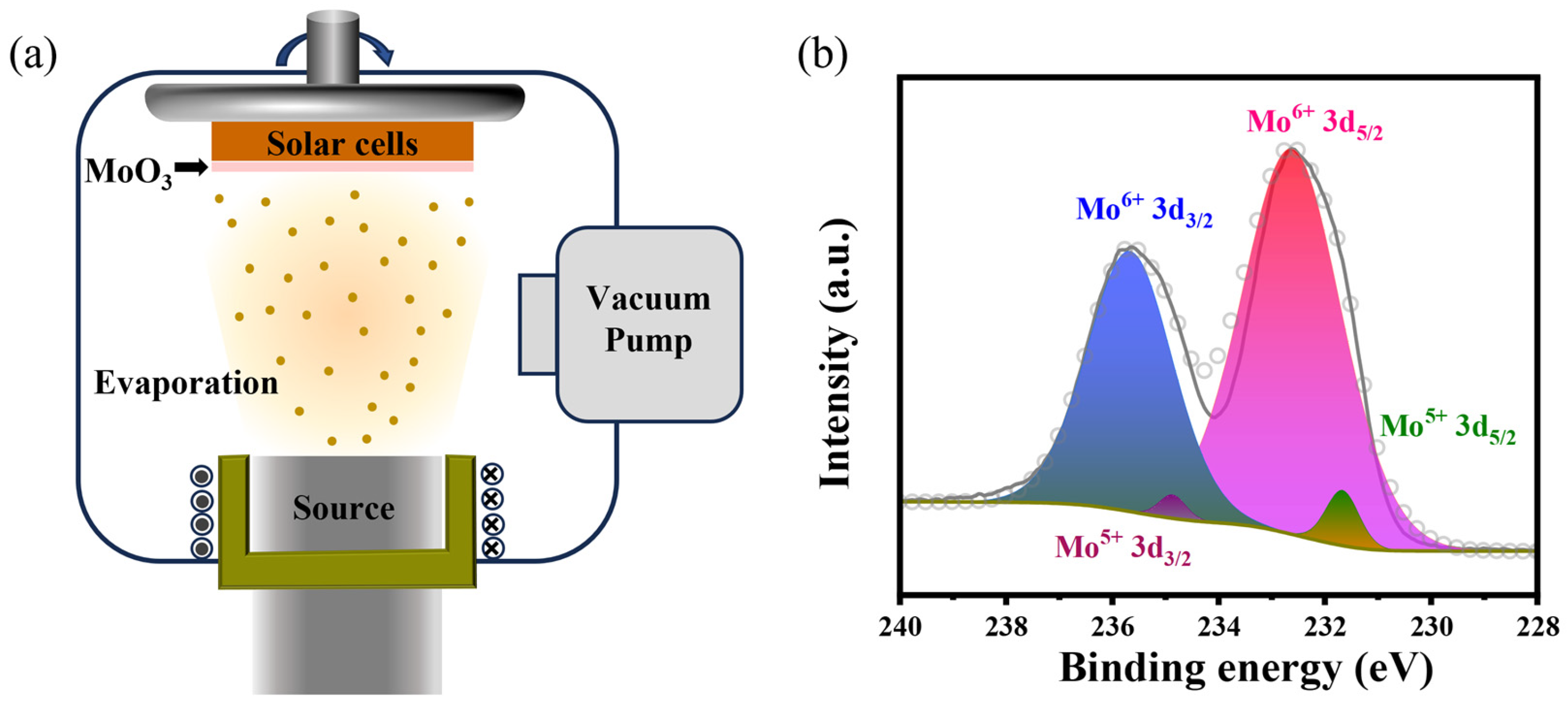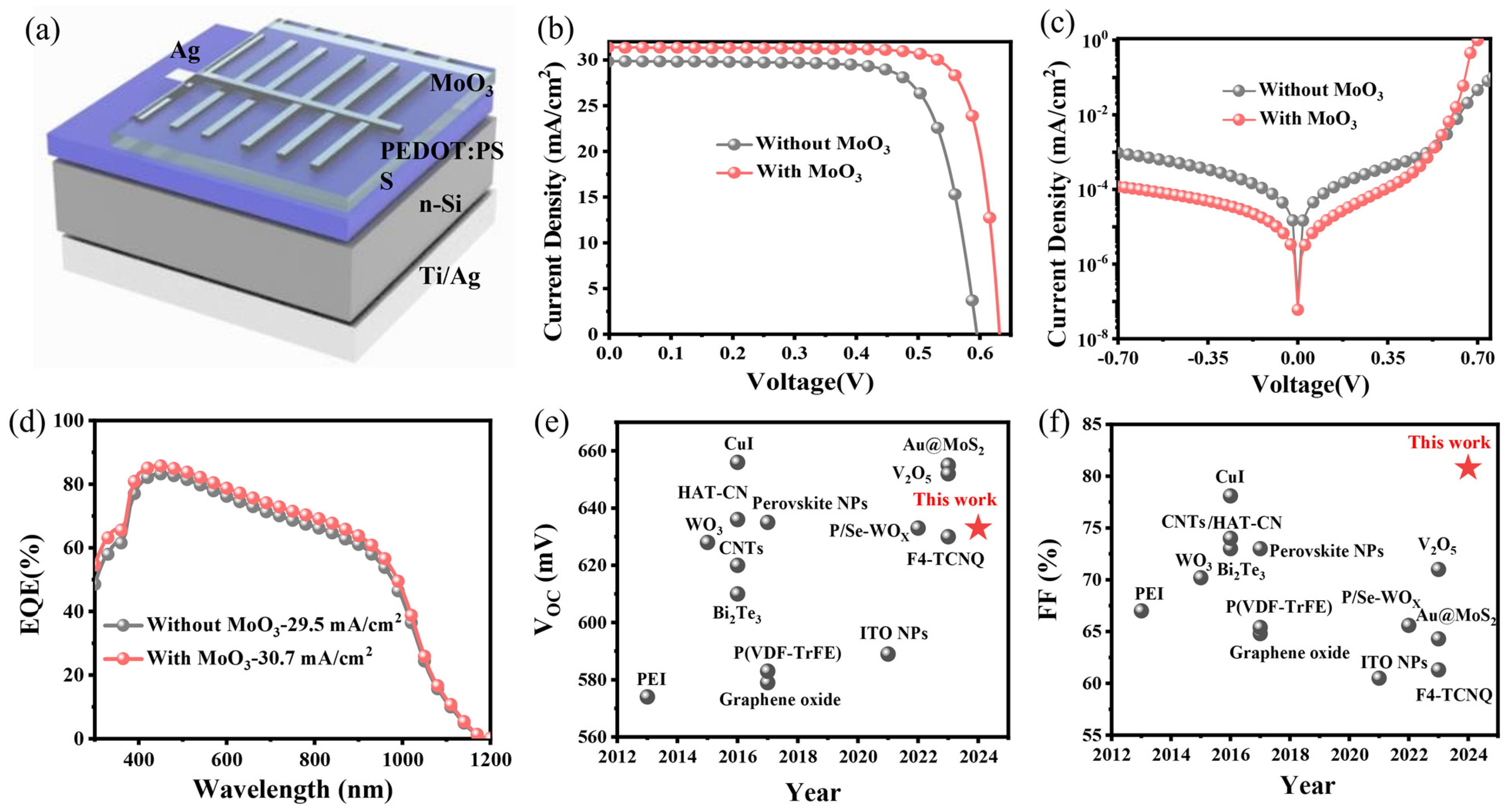Highly Efficient Organic/Silicon Hybrid Solar Cells with a MoO3 Capping Layer
Abstract
:1. Introduction
2. Materials and Methods
2.1. Device Fabrication
2.2. Device Characterization
3. Results and Discussion
4. Conclusions
Supplementary Materials
Author Contributions
Funding
Data Availability Statement
Conflicts of Interest
References
- Lin, H.; Yang, M.; Ru, X.; Wang, G.; Yin, S.; Peng, F.; Hong, C.; Qu, M.; Lu, J.; Fang, L.; et al. Silicon heterojunction solar cells with up to 26.81% efficiency achieved by electrically optimized nanocrystalline-silicon hole contact layers. Nat. Energy 2023, 8, 789–799. [Google Scholar] [CrossRef]
- Holman, Z.C.; Descoeudres, A.; Barraud, L.; Fernandez, F.Z.; Seif, J.P.; De Wolf, S.; Ballif, C. Current Losses at the Front of Silicon Heterojunction Solar Cells. IEEE J. Photovolt. 2012, 2, 7–15. [Google Scholar] [CrossRef]
- Zhong, S.; Dreon, J.; Jeangros, Q.; Aydin, E.; De Wolf, S.; Fu, F.; Boccard, M.; Ballif, C. Mitigating Plasmonic Absorption Losses at Rear Electrodes in High-Efficiency Silicon Solar Cells Using Dopant-Free Contact Stacks. Adv. Funct. Mater. 2019, 30, 1907840. [Google Scholar] [CrossRef]
- Qu, X.; He, Y.; Qu, M.; Ruan, T.; Chu, F.; Zheng, Z.; Ma, Y.; Chen, Y.; Ru, X.; Xu, X.; et al. Identification of embedded nanotwins at c-Si/a-Si:H interface limiting the performance of high-efficiency silicon heterojunction solar cells. Nat. Energy 2021, 6, 194–202. [Google Scholar] [CrossRef]
- Yang, X.; Xu, H.; Liu, W.; Bi, Q.; Xu, L.; Kang, J.; Hedhili, M.N.; Sun, B.; Zhang, X.; De Wolf, S. Atomic Layer Deposition of Vanadium Oxide as Hole-Selective Contact for Crystalline Silicon Solar Cells. Adv. Electron. Mater. 2020, 6, 2000467. [Google Scholar] [CrossRef]
- Liu, Z.; Lin, W.; Chen, Z.; Chen, D.; Chen, Y.; Shen, H.; Liang, Z. Enhanced Hole Extraction of WOX/V2OX Dopant-Free Contact for p-type Silicon Solar Cell. Adv. Mater. Interfaces 2022, 9, 2102374. [Google Scholar] [CrossRef]
- Cao, S.; Li, J.; Zhang, J.; Lin, Y.; Lu, L.; Wang, J.; Yin, M.; Yang, L.; Chen, X.; Li, D. Stable MoOX-Based Heterocontacts for p-Type Crystalline Silicon Solar Cells Achieving 20% Efficiency. Adv. Funct. Mater. 2020, 30, 2004367. [Google Scholar] [CrossRef]
- Dréon, J.; Jeangros, Q.; Cattin, J.; Haschke, J.; Antognini, L.; Ballif, C.; Boccard, M. 23.5%-efficient silicon heterojunction silicon solar cell using molybdenum oxide as hole-selective contact. Nano Energy 2020, 70, 104495. [Google Scholar] [CrossRef]
- Cao, L.; Procel, P.; Alcañiz, A.; Yan, J.; Tichelaar, F.; Özkol, E.; Zhao, Y.; Han, C.; Yang, G.; Yao, Z.; et al. Achieving 23.83% conversion efficiency in silicon heterojunction solar cell with ultra-thin MoOX hole collector layer via tailoring (i) a-Si:H/MoOX interface. Prog. Photovolt. 2022, 31, 1245–1254. [Google Scholar] [CrossRef]
- He, J.; Gao, P.; Yang, Z.; Yu, J.; Yu, W.; Zhang, Y.; Sheng, J.; Ye, J.; Amine, J.C.; Cui, Y. Silicon/Organic Hybrid Solar Cells with 16.2% Efficiency and Improved Stability by Formation of Conformal Heterojunction Coating and Moisture-Resistant Capping Layer. Adv. Mater. 2017, 29, 1606321. [Google Scholar] [CrossRef]
- Yoon, S.S.; Khang, D.Y. High Efficiency (>17%) Si-Organic Hybrid Solar Cells by Simultaneous Structural, Electrical, and Interfacial Engineering via Low-Temperature Processes. Adv. Energy Mater. 2017, 8, 1702655. [Google Scholar] [CrossRef]
- Shen, R.; Sun, Z.; Shi, Y.; Zhou, Y.; Guo, W.; Zhou, Y.; Yan, H.; Liu, F. Solution Processed Organic/Silicon Nanowires Hybrid Heterojunction Solar Cells Using Organosilane Incorporated Poly (3,4-ethylenedioxythiophene): Poly (styrenesulfonate) as Hole Transport Layers. ACS Nano 2021, 15, 6296–6304. [Google Scholar] [CrossRef] [PubMed]
- Wu, S.; Cui, W.; Aghdassi, N.; Song, T.; Duhm, S.; Lee, S.T.; Sun, B. Nanostructured Si/Organic Heterojunction Solar Cells with High Open-Circuit Voltage via Improving Junction Quality. Adv. Funct. Mater. 2016, 26, 5035–5041. [Google Scholar] [CrossRef]
- Tong, H.; Yang, Z.; Wang, X.; Liu, Z.; Chen, Z.; Ke, X.; Sui, M.; Tang, J.; Yu, T.; Ge, Z.; et al. Dual Functional Electron-Selective Contacts Based on Silicon Oxide/Magnesium: Tailoring Heterointerface Band Structures while Maintaining Surface Passivation. Adv. Energy Mater. 2018, 8, 1702921. [Google Scholar] [CrossRef]
- Lu, Z.; Liu, X.; Hou, G.; Chen, J.; Zhu, T.; Xu, J.; Chen, K. Doping-Free Titanium Nitride Carrier Selective Contacts for Efficient Organic–Inorganic Hybrid Solar Cells. ACS Appl. Energy Mater. 2020, 3, 9208–9215. [Google Scholar] [CrossRef]
- Lu, Z.; Hou, G.; Chen, J.; Xu, J.; Chen, K. Achieving a Record Open-Circuit Voltage for Organic/Si Hybrid Solar Cells by Improving Junction Quality. Sol. RRL 2021, 5, 2100255. [Google Scholar] [CrossRef]
- Kang, S.B.; Park, W.J.; Jeong, M.H.; Kang, S.H.; Yang, C.; Choi, K.J. Ambipolar Passivated Back Surface Field Layer for Silicon Photovoltaics. Adv. Funct. Mater. 2020, 30, 2004943. [Google Scholar] [CrossRef]
- Sheng, J.; Fan, K.; Wang, D.; Han, C.; Fang, J.; Gao, P.; Ye, J. Improvement of the SiOX Passivation Layer for High-Efficiency Si/PEDOT:PSS Heterojunction Solar Cells. ACS Appl. Mater. Interfaces 2014, 6, 16027–16034. [Google Scholar] [CrossRef]
- Lee, Y.-T.; Lin, F.-R.; Chen, C.-H.; Pei, Z. A 14.7% Organic/Silicon Nanoholes Hybrid Solar Cell via Interfacial Engineering by Solution-Processed Inorganic Conformal Layer. ACS Appl. Mate. Interfaces 2016, 8, 34537–34545. [Google Scholar] [CrossRef]
- Chen, T.-G.; Huang, B.-Y.; Chen, E.-C.; Yu, P.; Meng, H.-F. Micro-textured conductive polymer/silicon heterojunction photovoltaic devices with high efficiency. Appl. Phys. Lett. 2012, 101, 33301. [Google Scholar] [CrossRef]
- Mondal, B.K.; Mostaque, S.K.; Rashid, M.A.; Kuddus, A.; Shirai, H.; Hossain, J. Effect of CdS and In3Se4 BSF layers on the photovoltaic performance of PEDOT:PSS/n-Si solar cells: Simulation based on experimental data. Superlattices Microstruct. 2021, 152, 106853. [Google Scholar] [CrossRef]
- Cui, Y.; Wei, J.; Xiong, Y.; Shang, Q.-Y.T.; Liu, Q.; Huang, L.; Zhang, Y.; Yu, W. PEDOT: PSS-Nafion/n-Si Hybrid Heterojunction TOPCon Solar Cells: Experiment and Simulation. J. Phys. Chem. C 2024, 128, 2767–2775. [Google Scholar] [CrossRef]
- Yu, P.; Tsai, C.-Y.; Chang, J.-K.; Lai, C.-C.; Chen, P.-H.; Lai, Y.-C.; Tsai, P.-T.; Li, M.-C.; Pan, H.-T.; Huang, Y.-Y.; et al. 13% Efficiency Hybrid Organic/Silicon-Nanowire Heterojunction Solar Cell via Interface Engineering. ACS Nano 2013, 7, 10780–10787. [Google Scholar] [CrossRef] [PubMed]
- He, J.; Wan, Y.; Gao, P.; Tang, J.; Ye, J. Over 16.7% Efficiency Organic-Silicon Heterojunction Solar Cells with Solution-Processed Dopant-Free Contacts for Both Polarities. Adv. Funct. Mater. 2018, 28, 1802192. [Google Scholar] [CrossRef]
- Shen, S.; Zhang, J.; Zhou, S.; Han, Y.; Gao, P.; Sun, B.; Zhao, N.; Wong, C.P. Nanostructured Silicon-Based Heterojunction Solar Cells with Double Hole-Transporting Layers. Adv. Electron. Mater. 2018, 5, 1800070. [Google Scholar] [CrossRef]
- Mu, X.; Yu, X.; Xu, D.; Shen, X.; Xia, Z.; He, H.; Zhu, H.; Xie, J.; Sun, B.; Yang, D. High efficiency organic/silicon hybrid solar cells with doping-free selective emitter structure induced by a WO3 thin interlayer. Nano Energy 2015, 16, 54–61. [Google Scholar] [CrossRef]
- He, J.; Gao, P.; Ling, Z.; Ding, L.; Yang, Z.; Ye, J.; Cui, Y. High-Efficiency Silicon/Organic Heterojunction Solar Cells with Improved Junction Quality and Interface Passivation. ACS Nano 2016, 10, 11525–11531. [Google Scholar] [CrossRef] [PubMed]
- Jiang, X.; Wang, Z.; Han, W.; Liu, Q.; Lu, S.; Wen, Y.; Hou, J.; Huang, F.; Peng, S.; He, D.; et al. High performance silicon–organic hybrid solar cells via improving conductivity of PEDOT:PSS with reduced graphene oxide. Appl. Surf. Sci. 2017, 407, 398–404. [Google Scholar] [CrossRef]
- Liu, D.; Zhang, Y.; Fang, X.; Zhang, F.; Song, T.; Sun, B. An 11%-Power-Conversion-Efficiency Organic–Inorganic Hybrid Solar Cell Achieved by Facile Organic Passivation. IEEE Electron Device Lett. 2013, 34, 345–347. [Google Scholar] [CrossRef]
- Zhao, Y.; Zhang, L.; Lv, M.; Jiao, C.; Cheng, P.; Fu, Y.; Li, J.; Liu, Q.; He, D. Improvement of the Optoelectrical Properties of a Transparent Conductive Polymer via the Introduction of ITO Nanoparticles and Its Application in Crystalline Silicon/Organic Heterojunction Solar Cells. ACS Appl. Mater. Interfaces 2021, 13, 31171–31179. [Google Scholar] [CrossRef]
- Duan, X.; Han, J.; Xia, Z.; Song, T.; Li, Q.; Li, H.; Sun, B. Semiconducting single-walled carbon nanotubes as interfacial modification layers for organic-Si solar cells. Org. Electron. 2016, 28, 205–209. [Google Scholar] [CrossRef]
- Kang, S.B.; Jeong, M.H.; Choi, I.Y.; Sohn, S.-D.; Kim, S.H.; Shin, H.-J.; Park, W.I.; Shin, J.C.; Song, M.H.; Choi, K.J. Self-assembled, highly crystalline porous ferroelectric poly(vinylidene fluoride-co-trifluoroethylene) interlayer for Si/organic hybrid solar cells. Nano Energy 2017, 41, 243–250. [Google Scholar] [CrossRef]
- Zhao, M.; Zhang, J.; Gao, N.; Song, P.; Bosman, M.; Peng, B.; Sun, B.; Qiu, C.W.; Xu, Q.H.; Bao, Q.; et al. Actively Tunable Visible Surface Plasmons in Bi2Te3 and their Energy-Harvesting Applications. Adv. Mater. 2016, 28, 3138–3144. [Google Scholar] [CrossRef] [PubMed]
- Wang, Y.; Xia, Z.; Liu, L.; Xu, W.; Yuan, Z.; Zhang, Y.; Sirringhaus, H.; Lifshitz, Y.; Lee, S.T.; Bao, Q.; et al. The Light-Induced Field-Effect Solar Cell Concept—Perovskite Nanoparticle Coating Introduces Polarization Enhancing Silicon Cell Efficiency. Adv. Mater. 2017, 29, 1606370. [Google Scholar] [CrossRef] [PubMed]
- Liu, Y.; Zhang, Z.-g.; Xia, Z.; Zhang, J.; Liu, Y.; Liang, F.; Li, Y.; Song, T.; Yu, X.; Lee, S.-t.; et al. High Performance Nanostructured Silicon–Organic Quasi p–n Junction Solar Cells via Low-Temperature Deposited Hole and Electron Selective Layer. ACS Nano 2015, 10, 704–712. [Google Scholar] [CrossRef]
- Ni, Z.; Ding, S.; Zhang, H.; Dai, R.; Chen, A.; Wang, R.; Zhang, J.; Zhou, Y.; Yang, J.; Sun, T.; et al. Phosphorus and Selenium Co-Doped WO3 Nanoparticles for Interface Modification and Photovoltaic Properties Enhancement of Monolayer Planar Silicon/PEDOT:PSS Hybrid Solar Cells. Adv. Mater. Interfaces 2022, 9, 2200812. [Google Scholar] [CrossRef]
- Yang, C.; Luo, Z.; Ma, W.; Li, S.; Lv, G.; Fu, K.; Liu, K.; Li, H.; Sun, H.; Chen, X. Study on the Fabrication of PEDOT:PSS/Si Hybrid Solar Cells Incorporated with F4TCNQ and VTMO. J. Phys. Chem. C 2023, 127, 7974–7986. [Google Scholar] [CrossRef]
- Wang, J.; Zhou, W.; Wei, Q.; Liu, G.; Yuan, X.; Pen, H.; Zhang, G.; Wang, R.; Wang, C.; Yang, Y. Effect of Au@MoS2 Contacted PEDOT:PSS on Work Function of Planar Silicon Hybrid Solar Cells. Adv. Mater. Interfaces 2023, 10, 2300187. [Google Scholar] [CrossRef]
- Luo, Z.; Yang, C.; Chen, X.; Ma, W.; Li, S.; Fu, K. Improving open-circuit voltage and short-circuit current of high-efficiency silicon-based planar heterojunction solar cells by combining V2O5 with PEDOT:PSS. J. Materiomics 2023, 9, 438–446. [Google Scholar] [CrossRef]





| Device | VOC (mV) | Jsc (mA/cm2) | FF (%) | PCE (%) | Rs (Ω·cm2) |
|---|---|---|---|---|---|
| w/o MoO3 | 595 | 29.8 | 75.4 | 13.4 | 4.5 |
| (593 ± 6) | (29.4 ± 0.5) | (75.1 ± 0.9) | (13.1 ± 0.3) | (4.7 ± 0.6) | |
| w/MoO3 | 632 | 31.4 | 80.8 | 16.0 | 2.5 |
| (631 ± 2) | (30.4 ± 0.5) | (80.0 ± 0.4) | (15.3 ± 0.4) | (2.9 ± 0.3) |
Disclaimer/Publisher’s Note: The statements, opinions and data contained in all publications are solely those of the individual author(s) and contributor(s) and not of MDPI and/or the editor(s). MDPI and/or the editor(s) disclaim responsibility for any injury to people or property resulting from any ideas, methods, instructions or products referred to in the content. |
© 2024 by the authors. Licensee MDPI, Basel, Switzerland. This article is an open access article distributed under the terms and conditions of the Creative Commons Attribution (CC BY) license (https://creativecommons.org/licenses/by/4.0/).
Share and Cite
Chen, J.; Lu, Z.; Wang, X.; Luo, Y.; Ma, Y.; Lou, G.; Chi, D.; Huang, S. Highly Efficient Organic/Silicon Hybrid Solar Cells with a MoO3 Capping Layer. Nanomaterials 2024, 14, 1630. https://doi.org/10.3390/nano14201630
Chen J, Lu Z, Wang X, Luo Y, Ma Y, Lou G, Chi D, Huang S. Highly Efficient Organic/Silicon Hybrid Solar Cells with a MoO3 Capping Layer. Nanomaterials. 2024; 14(20):1630. https://doi.org/10.3390/nano14201630
Chicago/Turabian StyleChen, Jiahui, Zhangbo Lu, Xiaoting Wang, Yuner Luo, Yun Ma, Gang Lou, Dan Chi, and Shihua Huang. 2024. "Highly Efficient Organic/Silicon Hybrid Solar Cells with a MoO3 Capping Layer" Nanomaterials 14, no. 20: 1630. https://doi.org/10.3390/nano14201630






